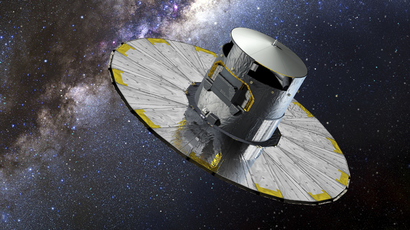Huge asteroid passes Earth nearly one year after Chelyabinsk meteorite

A massive asteroid is scheduled to make its way past Earth Monday night. Scientists advise it will not make contact with our planet, while amateur astronomers will be able to watch its flight online.
The space-rock known officially as 2000 EM26 passed over Earth Monday night at 02:00 GMT February 18 (21:00 EST). Scientists estimated that it was 270 meters (885 feet) in diameter, roughly equivalent to three football fields, and soared through the stars at a whopping 12.37 km/s (27,000 mph).
At its closest point, the asteroid was approximately 8.8 lunar distances from the Earth’s surface. One lunar distance is roughly 383,022.92 kilometers (238,000 miles), meaning asteroid 2000 EM26 was a mere 3,370,601.696 kilometers (2,094,400 miles) away.
“We continue to discover these potentially hazardous asteroids – sometimes only days before they make their close approaches to Earth,” wrote Slooh’s technical and researcher Paul Cox in a statement Monday. “Slooh’s asteroid research campaign is gathering momentum with Slooh members using the Slooh robotic telescopes to monitor this huge population of potentially hazardous space rocks. We need to find them before they find us!”
Coincidentally, the fly-by comes almost one year to the day after a much smaller asteroid exploded in the sky above Chelyabinsk, Russia. The 65-foot rock exploded 18 miles above the ground, but Slooh officials said the energy released was equivalent to 20 atom bomb explosions. The concussion alone was enough to damage thousands of buildings and leave more than 1,000 injured by broken glass.
Another astrological event from 1908 lives on in myth as much as it does in science books. What is thought to have been an asteroid or comet exploded in the air above the Podkamennaya Tunguska River near what is now Krasnoyarsk Krai in the Siberian region of Russia.
The blast is classified as the largest impact event on or near Earth in recorded history and its mysterious cause has partly contributed to the massive number of research papers, over 1,000, to focus on the event.
“On a practical level, previously-unknown, undiscovered asteroid seems to hit our planet and cause damage or injury once a century or so, as we witnessed on June 20, 1908 and February 15, 2013,” astronomer Bob Berman told Slooh.
“Every few centuries, an even more massive asteroid strikes us – fortunately usually impacting in an ocean or wasteland such as Antarctica. But the ongoing threat, and the fact that biosphere-altering events remain a real if small annual possibility, suggests that discovering and tracking all [near Earth objects], as well as setting up contingency plans for deflecting them on short notice should the need arise, would be a wise use of resources.”















